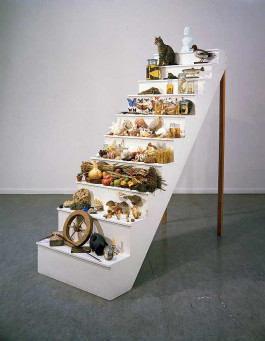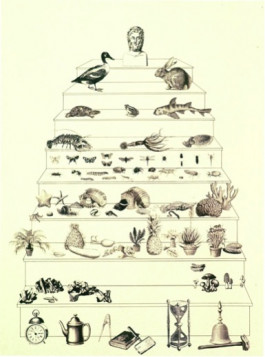
INS 024 Scala Naturae Mark Dion 1994
Header image:
© Mark Dion
Text: Heather Cammarata-Seale
Contemporary artist Mark Dion examines how society represents nature. In his work, Dion adopts scientific methods of collecting, ordering, and presentation in order to subvert the institutional systems that frame our understanding of the natural world. Wielding wit and ironic insight, Dion criticizes ideologies presented by accepted authorities such as the natural history museum to dismantle established hierarchies and build holistic taxonomies. Dion’s postmodern practice strives to destabilize Enlightenment isolationism and dethrone man from Aristotle’s Great Chain of Being by returning to antiquated modes of ordering as seen in the Wunderkammers of the sixteenth to eighteenth centuries. These Cabinets of Curiosity rejected rigid hierarchies. They championed idiosyncratic arrangements of natural and man-made specimens, forming collections that demonstrated the interconnectedness of man and nature rather than their separation.

Dion also appropriates the materials of natural science, such as taxidermied animals, to reveal the contradictions of scientific practices. When presented in a natural history museum, taxidermied specimens are accepted as actual animals. However, taxidermy is fashioned by man killing, skinning, re-arranging, and stuffing the pelt of an animal to preserve it. Composed of both animal and manmade materials, taxidermy is a constructed rather than untouched representation of an animal. Caught between the worlds of nature and culture, taxidermy blurs boundaries, disrupts dominant systems of order, and challenges traditional notions of humanity being disconnected from nature.
In Scala Naturae, Dion subverts Aristotle’s efforts to classify life according to an unyielding hierarchical system. Dion fills a staircase with natural specimens, taxidermied creatures, and man-made artifacts. At first glance, the installation appears to follow a predictable ordering system. However, upon closer examination, the piece shatters expectations. A wooden wheel, an arrow, and a clock sit at the bottom of the staircase while vegetables, seashells, and butterflies fill the steps above. The staircase is crowned with a bust of Aristotle but a stuffed tabby cat patiently waits on the second stair for its chance to reign supreme.
Related projects

INS 024 Scala Naturae Mark Dion 1994
Header image © Mark Dion
Text: Heather Cammarata-Seale
Contemporary artist Mark Dion examines how society represents nature. In his work, Dion adopts scientific methods of collecting, ordering, and presentation in order to subvert the institutional systems that frame our understanding of the natural world. Wielding wit and ironic insight, Dion criticizes ideologies presented by accepted authorities such as the natural history museum to dismantle established hierarchies and build holistic taxonomies. Dion’s postmodern practice strives to destabilize Enlightenment isolationism and dethrone man from Aristotle’s Great Chain of Being by returning to antiquated modes of ordering as seen in the Wunderkammers of the sixteenth to eighteenth centuries. These Cabinets of Curiosity rejected rigid hierarchies. They championed idiosyncratic arrangements of natural and man-made specimens, forming collections that demonstrated the interconnectedness of man and nature rather than their separation.
Dion also appropriates the materials of natural science, such as taxidermied animals, to reveal the contradictions of scientific practices. When presented in a natural history museum, taxidermied specimens are accepted as actual animals. However, taxidermy is fashioned by man killing, skinning, re-arranging, and stuffing the pelt of an animal to preserve it. Composed of both animal and manmade materials, taxidermy is a constructed rather than untouched representation of an animal. Caught between the worlds of nature and culture, taxidermy blurs boundaries, disrupts dominant systems of order, and challenges traditional notions of humanity being disconnected from nature.
In Scala Naturae, Dion subverts Aristotle’s efforts to classify life according to an unyielding hierarchical system. Dion fills a staircase with natural specimens, taxidermied creatures, and man-made artifacts. At first glance, the installation appears to follow a predictable ordering system. However, upon closer examination, the piece shatters expectations. A wooden wheel, an arrow, and a clock sit at the bottom of the staircase while vegetables, seashells, and butterflies fill the steps above. The staircase is crowned with a bust of Aristotle but a stuffed tabby cat patiently waits on the second stair for its chance to reign supreme.

Related projects


